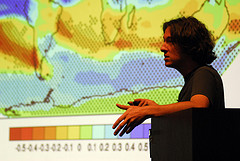- Oldest rice research facility in Western Hemisphere turns 100.
- ICRISAT DG plugs his genebank, says “India should start investing for the long-term sustainability of the farming sector particularly in dryland agriculture.”
- Seed-saving in Arkansas.
- The Archaeobotanist reviews rice domestication. And again.
- Nordics to discuss how to develop products based on local livestock breeds.
Nibbles: Sheep size, Insect populations, Tuna, Forest regeneration, Buffalo in India
- Climate change shrinking sheep, exploding insect populations.
- Japanese boffins sequencing tuna genome, planning super-tuna. Godzilla unavailable for comment.
- Birds eat beetles which eat seeds. So no birds, no forest. Such is the wonderful web of life.
- Buffalo cloning and its future. But what is that guy in the picture doing?
Agribusiness at the trough
I’m not fully up-to-date with the latest wiles of industrial agriculture in the US, but I do have the feeling that they are spoiling things for everyone with their subsidies and special exemptions. Fortunately, I can read Susan Schneider’s latest post at Agricultural Law: Agriculture’s embarrassment. She refers to a column by Steven Pearlstein in the Washington Post that lays bare the self-serving antics of the farm lobby, and I’m pretty sure that what happens in the US happens in most other developed countries (but maybe not New Zealand).
Two things seem to be at work here. One is the public view — fostered by all those little-red-barn-and-mixed-livestock-in-the-kindly-farmer’s-yard books for children — that just about everything is fine on Old MacDonald’s farm, and that to thank Old MacDonald for the loving care he takes over our food supply we better give him what he asks for. The other is the reality of industrial food production, which nobody — least of all the food industry — wants anyone to know about.
The eating public — and what does consumer mean, after all? — really needs to open its eyes to what is being done in its name.
Meantime, Susan Schneider has the last word:
The agricultural community should stop to consider not only its own long range interest in climate protection, but to consider the public good that we all need keep in mind in order to address the issue of climate change. And, if it really wants to be selfish, it can also consider the backlash that may well be coming. Pearlman concludes his article with the following:
“The next time the world’s most selfish lobby comes to Washington demanding drought relief, someone ought to have the good sense to tell them to go pound sand.”
An industry so wedded to government support and special treatment should pick its battles wisely.
It is time for the agricultural industry to grow up and acknowledge that there are environmental problems that EVERYONE needs to work together to address.
Cold comfort on climate change

We face a serious scientific gap in understanding crop substitution, current models assume that a maize farmer today will be a maize farmer tomorrow. In reality, many will need to select a different crop to what they have now.
Perhaps Marshall Burke and his team will now crank the machine and make some genetically nuanced predictions about how much change of crops — rather than varieties within a crop — might be needed. But that will require some pretty fundamental understanding of how and under what circumstances farmers adopt new (or old) crops and how best to facilitate that process. How much do the social anthropologists know about this?
Corn and Capitalism: How a Botanical Bastard Grew to Global Dominance, which I’ve mentioned before, has many insights into the factors that resulted in the rapid uptake of maize in Africa. But can the factors that promoted maize be easily reversed to favour sorghum or pearl millet? I have no idea, but I doubt it. How many crop failures will it take before either farmers or their advisors are willing to try something new?
And in other climate change news, a series of policy briefs from the International Food Policy Research Institute sets out An Agenda for Negotiation in Copenhagen. Detailed proposals are in the briefs. Executive summary:
- Investments. There must be explicit inclusion of agriculture-related investments, especially as part of a Global Climate Change Fund.
- Incentives. There must be a deliberate focus on introducing incentives to reduce emissions and support technological change.
- Information. There must be a solid commitment to establishing comprehensive information and monitoring services in soil and land use management for verification purposes.
Stay tuned.
Nibbles: Bamboo, Methane, Obama, Pests
- Fiat ghost paper. From bamboo.
- “If a cow burps, how do you measure it?“
- Recruiting drive: “I want you to continue to be my little ambassadors in your own home and your own communities.”
- “Insects and humans compete for food.” Say it isn’t so, Lubin Library.